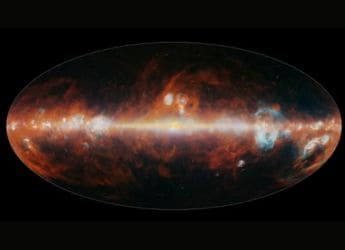- Home
- Science
- Science News
- Astronomers Capture Stunning Image of Black Hole Eruption Covering Length of 16 Full Moons
Astronomers Capture Stunning Image of Black Hole Eruption Covering Length of 16 Full Moons
A black hole is a region in time-space where the strong gravity does not allow anything — not even light — to escape.

Photo Credit: Ben McKinley, ICRAR/ Curtin and Connor Matherne, Louisiana State University
Astronomers captured the incredible image of black hole emission at the centre of Centaurus A galaxy
Astronomers frequently produce images and make discoveries that take us by surprise and leave us wondering what else the universe could be hiding. Black holes are an example of an object with a lot of promise for astronomical discoveries. Scientists have now created the most detailed image of radio emission from the closest supermassive black hole to the Earth. This near-light-speed eruption spreads eight degrees across the sky when observed from the Earth. This suggests that the eruption could span the length of 16 full Moons if they were lined up side by side.
A black hole usually goes through a cycle of hibernation and activity. It is a region in time-space where the strong gravity does not allow anything — not even light — to escape. Black holes feed on gases falling inside them and eject material outside, which prevents them from growing fast. This process creates ‘radio bubbles' to grow over hundreds of millions of years.
Using the Murchison Widefield Array (MWA) telescope in outback Western Australia, the astronomers captured the incredible image of the black hole emission at the centre of the Centaurus A galaxy, the closest radio galaxy to our own Milky Way, at a distance of about 12 million light-years.
The research has been published in the journal Nature Astronomy.
Lead author Benjamin McKinley said the image reveals spectacular new details. Earlier radio views were unable to cope with the intense brightness of the jets, and details of the areas surrounding the galaxy were distorted, said McKinley. He told the Perth-based International Centre for Radio Astronomy Research (ICRAR) that the new image overcame these obstacles.
McKinley added that since Centaurus A was so close to the Earth and could be observed in detail, a lot can be learnt from it “not just at radio wavelengths, but at all other wavelengths of light as well”.
ICRAR has also produced a video that shows the apparent size of the Centaurus A galaxy at different wavelengths.
Get your daily dose of tech news, reviews, and insights, in under 80 characters on Gadgets 360 Turbo. Connect with fellow tech lovers on our Forum. Follow us on X, Facebook, WhatsApp, Threads and Google News for instant updates. Catch all the action on our YouTube channel.
- Samsung Galaxy Unpacked 2025
- ChatGPT
- Redmi Note 14 Pro+
- iPhone 16
- Apple Vision Pro
- Oneplus 12
- OnePlus Nord CE 3 Lite 5G
- iPhone 13
- Xiaomi 14 Pro
- Oppo Find N3
- Tecno Spark Go (2023)
- Realme V30
- Best Phones Under 25000
- Samsung Galaxy S24 Series
- Cryptocurrency
- iQoo 12
- Samsung Galaxy S24 Ultra
- Giottus
- Samsung Galaxy Z Flip 5
- Apple 'Scary Fast'
- Housefull 5
- GoPro Hero 12 Black Review
- Invincible Season 2
- JioGlass
- HD Ready TV
- Laptop Under 50000
- Smartwatch Under 10000
- Latest Mobile Phones
- Compare Phones
- Huawei Nova 15
- Huawei Nova 15 Pro
- Huawei Nova 15 Ultra
- OnePlus 15R
- Realme Narzo 90x 5G
- Realme Narzo 90 5G
- Vivo S50 Pro Mini
- Vivo S50
- Asus ProArt P16
- MacBook Pro 14-inch (M5, 2025)
- Huawei MatePad 11.5 (2026)
- OnePlus Pad Go 2 (5G)
- OnePlus Watch Lite
- Just Corseca Skywatch Pro
- Acerpure Nitro Z Series 100-inch QLED TV
- Samsung 43 Inch LED Ultra HD (4K) Smart TV (UA43UE81AFULXL)
- Asus ROG Ally
- Nintendo Switch Lite
- Haier 1.6 Ton 5 Star Inverter Split AC (HSU19G-MZAID5BN-INV)
- Haier 1.6 Ton 5 Star Inverter Split AC (HSU19G-MZAIM5BN-INV)












